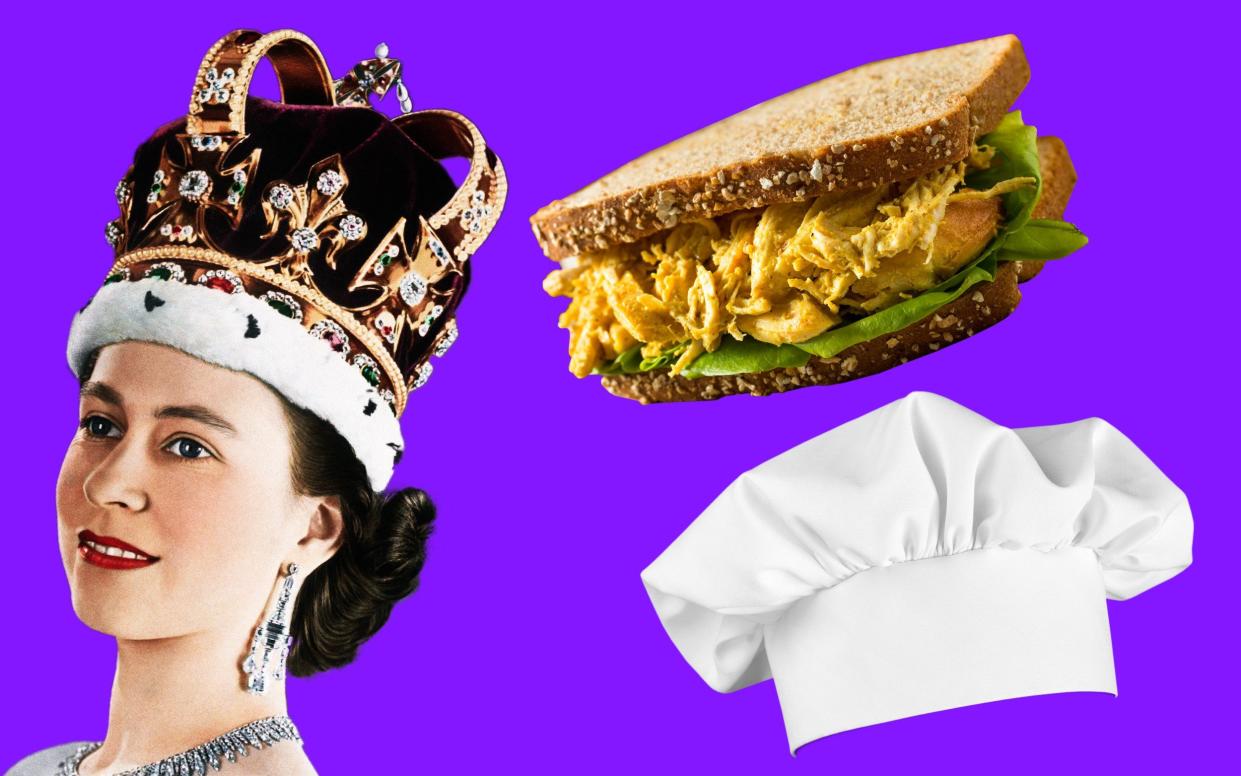How Le Cordon Bleu London created the iconic coronation chicken recipe

On June 2 1953, at two o’clock in the afternoon, 350 foreign dignitaries sat down to tuck into the Coronation luncheon after Queen Elizabeth II was crowned. They were served Poulet Reine Elizabeth: a dish that is now better known as coronation chicken.
In the 70 years since, it has gone from a luxury fit for dignitaries, to a lurid 1970s staple, to an enduringly popular supermarket sandwich filling and a regular fixture on bad buffets.
Where did it come from? One common origin theory is that coronation chicken was based on a recipe created for George V’s Silver Jubilee. Others mistakenly say it was made to be served to the Queen (it wasn’t).
Instead, Poulet Reine Elizabeth was created by Rosemary Hume and her students at Le Cordon Bleu cookery school in London specifically for the coronation banquet for visiting dignitaries. Constance Spry, the society florist in charge of organising the luncheon, also played a part, although she didn’t have quite as important a role as she is often given credit for.
“[Hume] came up with the dish and then two days later she said it had been inspired by a canapé in Mrs De Salis’ cookbook Savouries à la Mode, which I’ve looked at, and it bears very little resemblance,” says food historian Dr Annie Grey. “I think we can credit [Hume] for it pretty much all on her own.”
Food for a crowd
It was created with practicality in mind. The luncheon was served in the Great Hall of Westminster School, which had limited cooking facilities. The menu needed to be suitable for a “large number of guests of varying and unknown tastes”, in Spry’s words.

“They needed to come up with dishes that were real crowd-pleasers, quite impressive but not budget breaking, and things that they could prepare without a kitchen,” says Gray. They settled on a cold chicken dish in a creamy, mildly curried sauce that, on the day, was washed down with Krug champagne.
Blingy or budget?
The other myth that tends to circulate is that coronation chicken was chosen as a budget-friendly option that home cooks could easily replicate: a recipe that struck the balance between “luxury and austerity” in postwar Britain.
Gray says that isn’t the case. “It’s hard to overplay how much of a blingy dish this would have been at the time… this is a nation that was still suffering from rationing,” she says. “Most people couldn’t afford to eat chicken; it was enormously expensive.”
Chicken was a treat and curry was unheard of so, initially, it wasn’t a dish that many people cooked at home. That started to change with the publication of the Constance Spry Cookery Book in 1956, which included the recipe for coronation chicken.
As home cooks emerged from an era of austerity, it rose in popularity. “It’s one of those dishes that seems to become popular outside Britain first, and then came back in,” explains Gray.” It wasn’t immediate, but certainly by the 1970s it was quite embedded in the psyche as a cold dish for mass catering.”
Twists and interpretations
Hume and Spry’s original recipe starts with a whole chicken poached in water and splash of wine with parsley, thyme and bay. The sauce is made from chopped onion, curry powder, tomato pureé, red wine, a bay leaf, lemon, apricot pureé and whipped cream. It contains a surprisingly lengthy list of ingredients, and the end result is quite different to the claggy, bright yellow coronation chicken you might associate with a subpar buffet.
“Of course, it got rapidly bastardised,” says Gray. “It became nothing like the original dish, which is actually very nice.” Now it’s often “just cold cooked chicken with mayonnaise and curry powder… and sometimes pineapple or sultanas, which really isn’t what it was.”
Chefs have freely adapted it over the years. Nigella’s irreverent take includes mango, lime, chillies and little gem lettuce. Heston Blumenthal adds coriander and nigella seeds. Gordon Ramsay lightens it with crème fraîche and, again, mango. Yotam Ottolenghi, meanwhile, has turned it into a coronation chicken and broccoli bake. But Hume and Spry’s original is a classic for a reason.
How to make Coronation chicken
To make coronation chicken for six to eight people, just as it would have passed the lips of the royal invitees of 1953:
First, poach two chickens for 40 minutes in water with a carrot, a splash of wine, thyme, bay leaf, parsley and four peppercorns. Cool in the liquid then remove the meat from the bones.
Set it aside and make the sauce. Heat a tablespoon of oil in a pan and add 2 tbsp of chopped onion. Cook gently for three minutes then add a dessertspoon of curry powder. Cook for a further two minutes.
Add one tsp of tomato purée, a glass of red wine, ¾ wineglass of water, one bay leaf, and bring to the boil. Then add a pinch each of salt, sugar and pepper, the juice of ½ a lemon and simmer for 5-10 minutes. Strain and cool.
Add the mixture slowly to 450ml mayonnaise, then stir in 1-2 tbsp of apricot purée (made from soaked and boiled dry apricots). Season again – the sauce must not be too sweet. Finish by adding 2-3 tbsp of whipped cream.
Add only enough sauce to coat the chicken lightly, then eat it with a rice salad.

 Yahoo News
Yahoo News 
